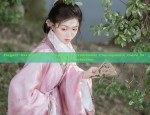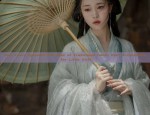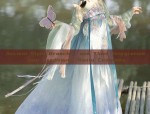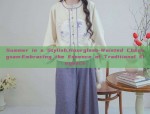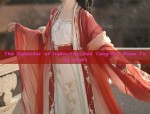The Revival of Chinese Hanfu:Embracing the Ancient Charm of Traditional Chinese Clothing
In the heart of China, a cultural revolution is quietly unfolding, centered around a resurgent interest in traditional clothing known as Hanfu. Hanfu, often described as the traditional attire of the Han ethnicity in China, is experiencing a renaissance as people worldwide embrace its unique beauty and cultural significance. This revival not only showcases the beauty of ancient Chinese culture but also serves as a testament to the enduring influence of traditional aesthetics in modern times.

The essence of Hanfu lies in its intricate designs and vibrant colors, embodying the essence of ancient Chinese aesthetics. It is more than just a piece of clothing; it is a symbol of cultural continuity and identity. The intricate patterns, vibrant hues, and meticulous craftsmanship found in Hanfu are not just artistic expressions but also reflect deep cultural values and historical significance.
The term "古风" (gǔ fēng), which translates to "ancient style" or "ancient charm," encapsulates the essence of Hanfu's appeal. It is a style that draws inspiration from ancient Chinese culture, art, and philosophy, often featuring elements like traditional patterns, elegant lines, and a focus on natural themes. This style not only encompasses the clothing but also encompasses the way people behave, speak, and present themselves, creating a holistic experience of ancient Chinese culture.
The revival of Hanfu and the embrace of ancient style in China are not just about fashion. It is a movement that reflects a deep-seated cultural pride and a desire to connect with one's roots. The rise of social media and online communities has further fueled this movement by providing a platform for people to share their love for Hanfu and ancient culture. From fashion bloggers to traditional craftmen, these communities are sharing their knowledge, experiences, and passion for Hanfu with a wider audience.
The influence of Hanfu and ancient style extends beyond China's borders, with global interest in this traditional clothing growing rapidly. Many international fashion enthusiasts are embracing Hanfu as part of their wardrobe, recognizing its unique beauty and cultural significance. This global interest not only brings recognition to Hanfu but also provides opportunities for traditional craftmen to revive their craft and for designers to experiment with traditional elements in modern contexts.
Moreover, the revival of Hanfu and ancient style is not just about fashion or aesthetics; it is about preserving and passing down a rich cultural heritage. The intricate craftsmanship, vibrant colors, and intricate designs found in Hanfu are not just artistic expressions but also reflect deep cultural values and historical significance. By embracing Hanfu and ancient style, people are not just adopting a fashion trend; they are also embracing a rich cultural heritage that dates back thousands of years.
In conclusion, the revival of Hanfu and the embrace of ancient style in China are not just about fashion; they are about preserving and nurturing a rich cultural heritage. It is a movement that reflects a deep-seated cultural pride and a desire to connect with one's roots. By embracing Hanfu and its associated culture, people are not just adopting a fashion trend; they are also embracing an integral part of their identity and history. As the movement continues to grow, it provides opportunities for cultural exchange, collaboration, and innovation, ensuring that the beauty and richness of Hanfu and ancient Chinese culture continue to thrive in modern times.

 Previous Post
Previous Post

